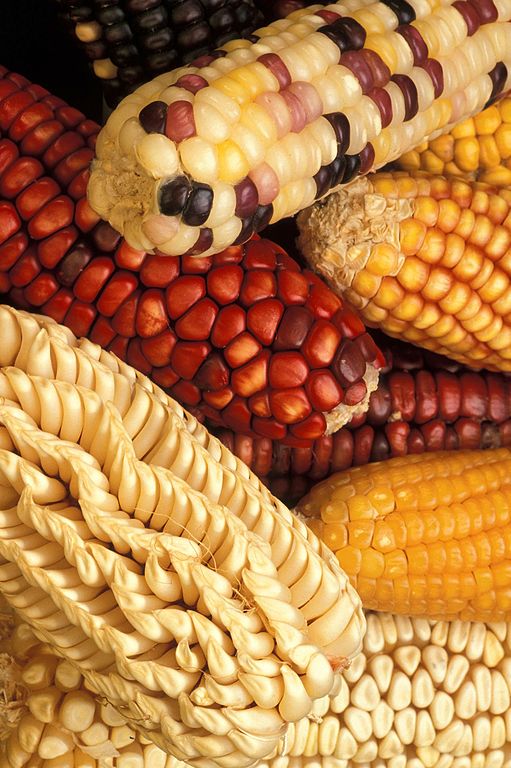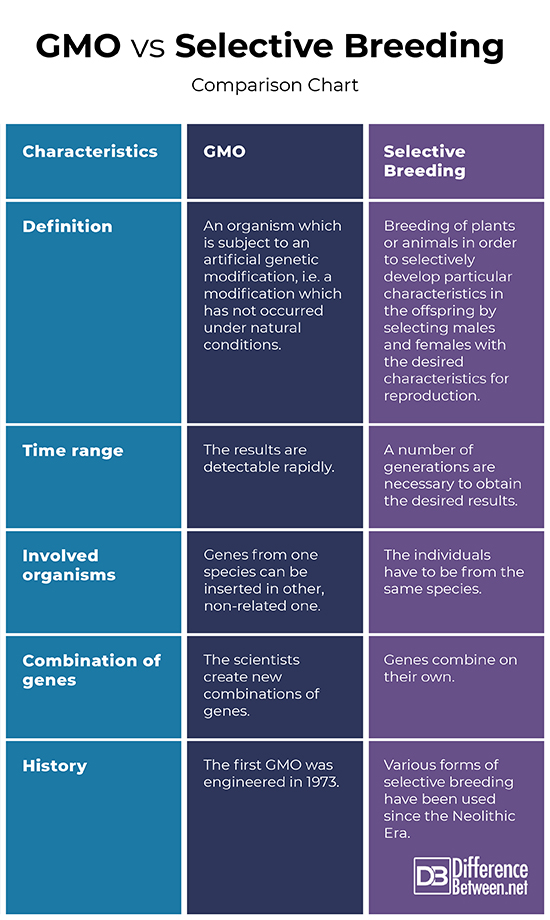Difference Between GMO and Selective Breeding
What is GMO?
A genetically modified organism (GMO) is an organism, which is subject to an artificial genetic modification, i.e. a modification which has not occurred under natural conditions. The genotype of the GMOs is modified with the help of genetic engineering to highlight some of its features, to obtain new ones, to reduce or eliminate some of the unwanted hereditary characteristics.
The first GMO was engineered in 1973.
The ways to create a genetically modified organism are:
- Re-combining DNA and creating new combinations of genetic material by incorporating nucleic acid molecules formed in another organism;
- Direct incorporation of hereditary genetic material by microinjection, macroinjection or microencapsulation;
- Protoplasmic or hybrid cell fusion;
The most commonly used modifications are:
- Changing the activity of the natural genes of the organism;
- Adding additional copies of the natural genes of the organism to its body;
- Adding genes of another species to the organism.
The third group of changes is often subject of criticism and denial because in natural conditions it is extremely rare (the so-called horizontal gene transfer is possible but is observed at a very low frequency).
GMOs are most commonly used in:
- Modification of microorganisms to produce desired chemical substances (e.g. insulin);
- Modification in crops to increase productivity, quality or resistance to diseases, pests, pesticides, etc.
Examples of GMOs are wheat modified with a scorpion gene to be drought-resistant, strawberries modified with bacterial genes for longer shelf life, rice modified with daffodil genes to produce beta-carotene, etc.
The most common plant GMOs in the world are soy, potatoes, corn, tomatoes, rice, etc.
What is Selective Breeding?
Selective breeding is breeding of plants or animals in order to selectively develop particular characteristics in the offspring by selecting males and females with the desired characteristics for reproduction.
An animal breed and plant variety are artificial, man-made variations of the same species of animal or plant. In selective breeding, the breeder aims to retain only those characteristics of the breeds and varieties which are of interest and may be inherited.
Various forms of selective breeding have been used since the dawn of human society. Unintentional selective breeding was carried out since the Neolithic Era. Later the unintentional selective breeding has become intentional, and in the meantime, many breeds and varieties have been created.
Selective breeding aims to enhance certain target characteristics of the species. For example, in the selection of watermelon seeds needed for sowing for the next season, farmers always prefer to harvest seed of the largest and sweetest fruits.
In the intentional selective breeding, the breeder sets a goal and draws up a plan to achieve it. The plan includes several important points:
- Determining the characteristics to be obtained.
- Excluding the individuals which apparently do not exhibit the desired characteristics.
- Selection and breeding of individuals with the desired characteristics.
For effective selective breeding, the following conditions have to be met:
- A large number of individuals subject to selection;
- Selection of the most appropriate individuals for breeding.
Through selective breeding were obtained cows with high-quality milk, different breeds of dogs and horses, numerous varieties of fruits, vegetables, cereals, fiber, and ornamental plants.
Difference Between GMO and Selective Breeding
-
Definition
GMO: GMO is an organism which is subject to an artificial genetic modification, i.e. a modification which has not occurred under natural conditions.
Selective Breeding: Selective breeding is breeding of plants or animals in order to selectively develop particular characteristics in the offspring by selecting males and females with the desired characteristics for reproduction.
-
Time range
GMO: The results of genetic engineering are detectable rapidly.
Selective Breeding: A number of generations are necessary to obtain the desired results of selective breeding.
-
Involved organisms
GMO: Genes from one species can be inserted in other, non-related one.
Selective Breeding: The individuals have to be from the same species.
-
Combination of genes
GMO: In GMO the scientists create new combinations of genes
Selective Breeding: In selective breeding, genes combine on their own.
-
History
GMO: The first GMO was engineered in 1973.
Selective Breeding: Various forms of selective breeding have been used since the dawn of human society.
GMO vs. Selective Breeding : Comparison Chart
Summary of GMO vs. Selective Breeding:
- GMO is an organism which is subject to an artificial genetic modification, i.e. a modification which has not occurred under natural conditions.
- Selective breeding is breeding of plants or animals in order to selectively develop particular characteristics in the offspring by selecting males and females with the desired characteristics for reproduction.
- The results of the genetic engineering are detectable in the first generation. A number of generations are necessary to obtain the desired results of the selective breeding.
- Via genetic engineering genes from one species can be inserted in other, non-related one. In selective breeding, the individuals have to be from the same species.
- In GMO the scientists create new combinations of genes. In selective breeding, genes combine on their own.
- The first GMO was produced in 1973. Various forms of selective breeding have been used since the dawn of human society.
- Difference Between Gallstones and Cholecystitis - September 5, 2021
- Difference Between Constipation and Cramping - August 4, 2021
- Difference Between Whole Genome Sequencing and Microarray - May 6, 2021
Search DifferenceBetween.net :
Leave a Response
References :
[0]Ayala, J., J. Kiger. Modern Genetics. San Francisco: Benjamin-Cummings Publishing Company. 1989. Print.
[1]Klug, W., M. Cummings. Concepts of Genetics (6th Edition). 1999. Print.
[2]Wood, Р., V. Orel. Genetic Prehistory in Selective Breeding: A Prelude to Mendel 1st Edition. New York: Oxford University Press. 2001. Print.
[3]Image credit: https://upload.wikimedia.org/wikipedia/commons/thumb/9/9e/Genetically_modified_corn.jpg/511px-Genetically_modified_corn.jpg
[4]Image credit: https://www.flickr.com/photos/fdaphotos/8737954801



